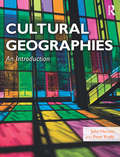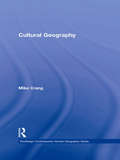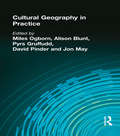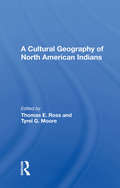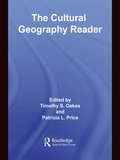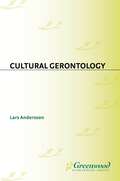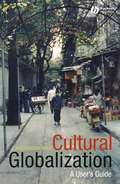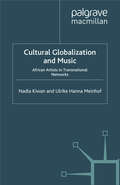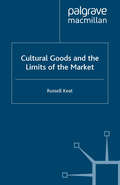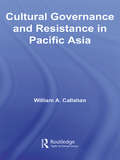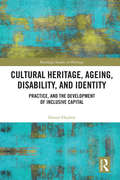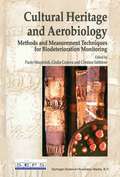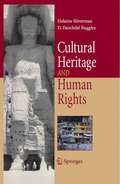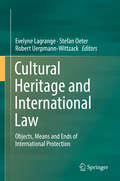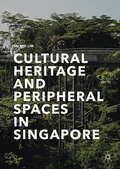- Table View
- List View
Cultural Geographies: An Introduction
by John Horton Peter KraftlCultural geography is a major, vibrant subdiscipline of human geography. Cultural geographers have done some of the most important, exciting and thought-provokingly zesty work in human geography over the last half-century. This book exists to provide an introduction to the remarkably diverse, controversial, and sometimes-infuriating work of cultural geographers. The book outlines how cultural geography in its various forms provides a rich body of research about cultural practices and politics in diverse contexts. Cultural geography offers a major resource for exploring the importance of cultural materials, media, texts and representations in particular contexts and is one of the most theoretically adventurous subdisciplines within human geography, engaging with many important lines of social and cultural theory. The book has been designed to provide an accessible, wide-ranging and thought-provoking introduction for students studying cultural geography, or specific topics within this subdiscipline. Through a wide range of case studies and learning activities, it provides an engaging introduction to cultural geography.
Cultural Geographies: An Introduction
by John Horton Peter KraftlCultural geography is a major, vibrant subdiscipline of human geography. Cultural geographers have done some of the most important, exciting and thought-provokingly zesty work in human geography over the last half-century. This book exists to provide an introduction to the remarkably diverse, controversial, and sometimes-infuriating work of cultural geographers. The book outlines how cultural geography in its various forms provides a rich body of research about cultural practices and politics in diverse contexts. Cultural geography offers a major resource for exploring the importance of cultural materials, media, texts and representations in particular contexts and is one of the most theoretically adventurous subdisciplines within human geography, engaging with many important lines of social and cultural theory. The book has been designed to provide an accessible, wide-ranging and thought-provoking introduction for students studying cultural geography, or specific topics within this subdiscipline. Through a wide range of case studies and learning activities, it provides an engaging introduction to cultural geography.
Cultural Geography
by Mike CrangFirst Published in 1998. Routledge is an imprint of Taylor & Francis, an informa company.
Cultural Geography
by Mike CrangFirst Published in 1998. Routledge is an imprint of Taylor & Francis, an informa company.
CULTURAL GEOGRAPHY IN PRACTICE
by Miles Ogborn Alison Blunt Pyrs Gruffudd David PinderCultural Geography in Practice provides an innovative and accessible approach to the sources, theories and methods of cultural geography. Written by an international team of prominent cultural geographers, all of whom are experienced researchers, this book is a fully illustrated guide to methodological approaches in cultural geography. In order to demonstrate the practice of cultural geography each chapter combines the following features:·Practical instruction in using one of the main methods of cultural geography (e.g. interviewing, interpreting texts and visual images, participatory methods)·An overview of a key area of concern in cultural geography (e.g. the body, national identity, empire, marginality)·A nuts and bolts description of the actual application of the theories and methods within a piece of researchWith the addition of boxed definitions of key concepts and descriptions of research projects by students who devised and undertook them, Cultural Geography in Practice is an essential manual of research practice for both undergraduate and graduate geography students.
CULTURAL GEOGRAPHY IN PRACTICE
by Miles Ogborn Alison Blunt David Pinder Pyrs GruffuddCultural Geography in Practice provides an innovative and accessible approach to the sources, theories and methods of cultural geography. Written by an international team of prominent cultural geographers, all of whom are experienced researchers, this book is a fully illustrated guide to methodological approaches in cultural geography. In order to demonstrate the practice of cultural geography each chapter combines the following features:·Practical instruction in using one of the main methods of cultural geography (e.g. interviewing, interpreting texts and visual images, participatory methods)·An overview of a key area of concern in cultural geography (e.g. the body, national identity, empire, marginality)·A nuts and bolts description of the actual application of the theories and methods within a piece of researchWith the addition of boxed definitions of key concepts and descriptions of research projects by students who devised and undertook them, Cultural Geography in Practice is an essential manual of research practice for both undergraduate and graduate geography students.
A Cultural Geography Of North American Indians
by Thomas E. RossThis book focuses on the effects of interaction between Indian and non-Indian peoples and on the complex relationships between Indians and their environments. It presents information for an accurate assessment of whether North American Indians can survive as a distinct culture. .
A Cultural Geography Of North American Indians
by Thomas E. Ross Tyrel G. MooreThis book focuses on the effects of interaction between Indian and non-Indian peoples and on the complex relationships between Indians and their environments. It presents information for an accurate assessment of whether North American Indians can survive as a distinct culture. .
The Cultural Geography Reader
by Timothy Oakes Patricia L. PriceThe Cultural Geography Reader draws together fifty-two classic and contemporary abridged readings that represent the scope of the discipline and its key concepts. Readings have been selected based on their originality, accessibility and empirical focus, allowing students to grasp the conceptual and theoretical tools of cultural geography through the grounded research of leading scholars in the field. Each of the eight sections begins with an introduction that discusses the key concepts, its history and relation to cultural geography and connections to other disciplines and practices. Six to seven abridged book chapters and journal articles, each with their own focused introductions, are also included in each section. The readability, broad scope, and coverage of both classic and contemporary pieces from the US and UK makes The Cultural Geography Reader relevant and accessible for a broad audience of undergraduate students and graduate students alike. It bridges the different national traditions in the US and UK, as well as introducing the span of classic and contemporary cultural geography. In doing so, it provides the instructor and student with a versatile yet enduring benchmark text.
The Cultural Geography Reader
by Timothy Oakes Patricia L. PriceThe Cultural Geography Reader draws together fifty-two classic and contemporary abridged readings that represent the scope of the discipline and its key concepts. Readings have been selected based on their originality, accessibility and empirical focus, allowing students to grasp the conceptual and theoretical tools of cultural geography through the grounded research of leading scholars in the field. Each of the eight sections begins with an introduction that discusses the key concepts, its history and relation to cultural geography and connections to other disciplines and practices. Six to seven abridged book chapters and journal articles, each with their own focused introductions, are also included in each section. The readability, broad scope, and coverage of both classic and contemporary pieces from the US and UK makes The Cultural Geography Reader relevant and accessible for a broad audience of undergraduate students and graduate students alike. It bridges the different national traditions in the US and UK, as well as introducing the span of classic and contemporary cultural geography. In doing so, it provides the instructor and student with a versatile yet enduring benchmark text.
Cultural Gerontology (Non-ser.)
by Lars AnderssonThe concept of culture has gained considerable attention within the humanities and social sciences in general, and this is certainly true in the field of gerontology. The new perspectives thus gained widen the scope of gerontology. In this study, chapter authors examine the growth of gerontology as a discipline, the phenomenon of ageism as a socio-cultural concept, identity politics in which older persons are perceived as belonging to a subculture, and images of the older body in cultural perspective.The manner in which gerontology emerged as a discipline was embedded in culturally defined views of aging that had consequences for how it was seen to vary between cultures. One consequence was a perception of ageism as a cultural construction. Since the 1980s, much of the politics of older people is a form of identity politics in which groups are mobilized to further their interests. Questions of cultural meanings ascribed to the gendered aging body is a central question for ageism, social identity, and self-image. These questions become especially relevant in confrontations with bodily decline and negotiations of intimacy in institutions for older people.
Cultural Globalization: A User's Guide
by J. MacGregor WiseCultural Globalization: A User’s Guide is a personal and engaging journey through theories of culture and globalization. Drawing on extensive examples and interdisciplinary research, Wise explores concepts of culture, territory and identity in order to give students a new perspective on issues of globalization. Includes numerous examples from Asian, European, and North American youth culture and popular music Draws on interdisciplinary research from the fields of anthropology, cultural studies, cultural geography, and media studies Considers how global processes carry with them the ethical questions of how to act in the world and how to care for others Provides an original and stimulating overview of theories of culture and globalization, encouraging students think more broadly about the key issues
Cultural Globalization and Music: African Artists in Transnational Networks
by Nadia Kiwan Ulrike Hanna MeinhofThis book is about South-North, North-South relations between Africa and Europe, presenting the personal narratives of musicians in different locations across Africa and Europe, and those of the people who constitute their networks within the wider artistic, cultural, and civil society milieus of globalizing societies.
Cultural Goods and the Limits of the Market
by R. KeatIn Cultural Goods and the Limits of the Market , Russell Keat presents a theoretical challenge to recent extensions of the market domain and the introduction of commercially modelled forms of organization in areas such as broadcasting, the arts and academic research. Drawing on Walzer's pluralistic conception of social goods, and MacIntyre's account of social practices, he argues that cultural activities of this kind, and the institutions within which they are conducted, can best make their distinctive contributions to human well-being when protected from the damaging effects of an unbounded market.
Cultural Governance and Resistance in Pacific Asia
by William A. CallahanThis text examines the politics of culture and the culture of politics in Pacific Asia through case studies on the South Pacific, China, South Korea, Thailand and Southeast Asia. The contexts and cultures of the chapters are wide-ranging and Callahan skilfully ties them together with the objective of analyzing the relation between the state’s cultural governance and resistance to it. The themes covered include: governmentality and cultural production popular culture and resistance East/West relations gender, identity and democracy civil society, social movements and democracy national and transnational identity production. Cultural Governance and Resistance in Pacific Asia addresses the dynamics between Asian studies and cultural studies, and the overlap between comparative politics and international relations, and as such will appeal to students and scholars of Asian studies, cultural studies, comparative politics, sociology and anthropology alike.
Cultural Governance and Resistance in Pacific Asia
by William A. CallahanThis text examines the politics of culture and the culture of politics in Pacific Asia through case studies on the South Pacific, China, South Korea, Thailand and Southeast Asia. The contexts and cultures of the chapters are wide-ranging and Callahan skilfully ties them together with the objective of analyzing the relation between the state’s cultural governance and resistance to it. The themes covered include: governmentality and cultural production popular culture and resistance East/West relations gender, identity and democracy civil society, social movements and democracy national and transnational identity production. Cultural Governance and Resistance in Pacific Asia addresses the dynamics between Asian studies and cultural studies, and the overlap between comparative politics and international relations, and as such will appeal to students and scholars of Asian studies, cultural studies, comparative politics, sociology and anthropology alike.
Cultural Heritage, Ageing, Disability, and Identity: Practice, and the development of inclusive capital
by Simon HayhoeCultural Heritage, Ageing, Disability, and Identity examines the effects of disability and ageing on engagement with cultural heritage and associated cultural identity formation processes. Combining theory with detailed case study research, it unpicks both the current state of play and future directions. The book is based upon detailed case example research on both the self-reported individual experiences of people with disabilities engaging with cultural heritage, and the accessibility approaches of cultural heritage institutions themselves. Hayhoe grounds the analysis in a theoretical and historical overview of disability and inclusion. He interrogates the various ways in which identity is formed through interaction with cultural heritage, and considers the differences in engagement with cultural heritage amongst those who develop disabilities early in life compared to those who acquire disabilities later in life. His conclusions offer insights that can help improve the provision of cultural heritage engagement to all people, but particularly those with disabilities. Cultural Heritage, Ageing, Disability, and Identity is key reading for students and scholars of cultural heritage, visitor studies, and disability studies, and will also be of interest to other subject areas engaging with issues of accessibility. It should also be read by institutions looking to improve their accessibility strategy to engage broader audiences.
Cultural Heritage, Ageing, Disability, and Identity: Practice, and the development of inclusive capital
by Simon HayhoeCultural Heritage, Ageing, Disability, and Identity examines the effects of disability and ageing on engagement with cultural heritage and associated cultural identity formation processes. Combining theory with detailed case study research, it unpicks both the current state of play and future directions. The book is based upon detailed case example research on both the self-reported individual experiences of people with disabilities engaging with cultural heritage, and the accessibility approaches of cultural heritage institutions themselves. Hayhoe grounds the analysis in a theoretical and historical overview of disability and inclusion. He interrogates the various ways in which identity is formed through interaction with cultural heritage, and considers the differences in engagement with cultural heritage amongst those who develop disabilities early in life compared to those who acquire disabilities later in life. His conclusions offer insights that can help improve the provision of cultural heritage engagement to all people, but particularly those with disabilities. Cultural Heritage, Ageing, Disability, and Identity is key reading for students and scholars of cultural heritage, visitor studies, and disability studies, and will also be of interest to other subject areas engaging with issues of accessibility. It should also be read by institutions looking to improve their accessibility strategy to engage broader audiences.
Cultural Heritage and Aerobiology: Methods and Measurement Techniques for Biodeterioration Monitoring
by CristinaSabbioni GiuliaCaneva PaoloMandrioliAerobiology is the science that studies the biological component of the atmosphere and its effects on living systems and on the environment. This term was used for the first time in 1935, but the attention of scientists to the biological component of the atmosphere goes back to 1769, when the Italian biologist Spallanzani carried out a series of experiments that disproved the concept of spontaneous generation of life and proved the presence of viable microorganisms in the air. Aerobiology has marked characteristics of interdisciplinarity: its application fields range from respiratory diseases to the airborne outbreak of animal and vegetal diseases and to the biodegradation of substances and materials. The latter is the subject of this book. The purpose of aerobiological research applied to the conservation of cultural heritage is to evaluate the risk of alteration by airborne microorganisms of materials forming artefacts of historical, artistic and archaeological interest. Airborne spores and vegetative structures may develop on different substrates and may be a cause of degradation, in relation to the types of materials, the microclimatic situation and the pollution of the conservation environments. The qualitative and quantitative evaluation of the biological component of air, performed by means of targeted analysis campaigns, and of the characteristics of materials and environments, supplies indispensable information for the evaluation of the actual risk and the planning of interventions. This book is divided into four main parts.
Cultural Heritage and Development in Fragile Contexts: Learning from the Interventions of International Cooperation in Afghanistan and Neighboring Countries (Research for Development)
by Mirella Loda Paola AbenanteThis open access book discusses cooperation strategies for safeguarding cultural heritage in nations facing diverse forms of fragility. Through case studies and a critical analysis, it explores preserving cultural heritage to spur regional socioeconomic development and community empowerment, focusing on the Middle East and Pakistan, with an in-depht exploration of the World Heritage site of Bamiyan, Afghanistan. The first section offers an overview of cultural heritage protection efforts since UNESCO designated Bamiyan Valley as a World Heritage Site in 2003, reflecting on challenges and successes before Taliban rule. The second section turns to the present situation, analysing the inerplay between heritage preservation, community involvement and policies addressing urban and demographic growth. The third section provides a review of relevant examples of cultural heritage preservation in the Middle East and Pakistan by the Italian Agency for Development Cooperation, UNESCO, and international NGOs. It highlights the relationship between heritage protection, sustainable development and the mitigation of social and economic fragilities. In the concluding section, the book synthesizes research findings and operational approaches, providing a nuanced understanding of the cultural heritage, development, and fragility in the Middle East. Concluding, in the fourth section, the book offers a comprehensive report on main methodological findings, also conferrable to other contexts both in terms of future research and operational activities.
Cultural Heritage and Human Rights
by Helaine Silverman D. Fairchild RugglesIs there a universal right to the free expression and preservation of cultural heritage, and if so, where is that right articulated and how can it be protected? No corner of today’s world has escaped the effects of globalization – for better or worse. This volume addresses a deeply political aspect of heritage preservation and management as it relates to human rights.
Cultural Heritage and International Law: Objects, Means and Ends of International Protection
by Evelyne Lagrange Stefan Oeter Robert Uerpmann-WittzackThis book explores the objects, means and ends of international cultural heritage protection. It starts from a broad conception of cultural heritage that encompasses both tangible property, such as museum objects or buildings, and intangible heritage, such as languages and traditions. Cultural heritage thus defined is protected by various legal regimes, including the law of armed conflicts, UNESCO Conventions and international criminal law. With a view to strengthening international protection, the authors analyze existing regimes and elaborate innovative concepts, such as blue helmets of culture and safe havens for endangered cultural heritage. Finally, the ends of international protection come to the fore, and the authors address possible conflicts between protecting cultural diversity and wishes to strengthen cultural identity.
Cultural Heritage and Mobility from a Multisensory Perspective (Routledge Studies in Heritage)
by Magdalena BanaszkiewiczCultural Heritage and Mobility from a Multisensory Perspective bridges the gap between cultural heritage and mobility studies through the employment of theoretical and methodological multisensory perspectives.An interdisciplinary volume covering a broad range of empirical cases, this book focuses on the engagement with cultural heritage in the context of mobility. The book presents a grassroots perspective of individual heritage performances by mobile and moving actors, analyzing them with close attention to their embodied aspects: bodily experiences, sensory impressions, and the affect and emotions they evoke. As a result, the collection of case studies presented covers empirical, theoretical, and methodological accounts of the embodiment of heritage in the context of mobility on macro, meso, and micro levels, exploring heritage change and mobility from a multisensory perspective. Cultural Heritage and Mobility from a Multisensory Perspective is primarily targeted at scholars, students and practitioners working within and at the intersection of the fields of cultural heritage and mobility. It will also be of interest to those engaged in the study of tourism, migration and integration studies.Chapters 2, 3, 4, 5, 13, 14 and Introduction of this book is freely available as a downloadable Open Access PDF at http://www.taylorfrancis.com under a Creative Commons Attribution-Non Commercial-No Derivatives (CC-BY-NC-ND) 4.0 license.
Cultural Heritage and Mobility from a Multisensory Perspective (Routledge Studies in Heritage)
Cultural Heritage and Mobility from a Multisensory Perspective bridges the gap between cultural heritage and mobility studies through the employment of theoretical and methodological multisensory perspectives.An interdisciplinary volume covering a broad range of empirical cases, this book focuses on the engagement with cultural heritage in the context of mobility. The book presents a grassroots perspective of individual heritage performances by mobile and moving actors, analyzing them with close attention to their embodied aspects: bodily experiences, sensory impressions, and the affect and emotions they evoke. As a result, the collection of case studies presented covers empirical, theoretical, and methodological accounts of the embodiment of heritage in the context of mobility on macro, meso, and micro levels, exploring heritage change and mobility from a multisensory perspective. Cultural Heritage and Mobility from a Multisensory Perspective is primarily targeted at scholars, students and practitioners working within and at the intersection of the fields of cultural heritage and mobility. It will also be of interest to those engaged in the study of tourism, migration and integration studies.Chapters 2, 3, 4, 5, 13, 14 and Introduction of this book is freely available as a downloadable Open Access PDF at http://www.taylorfrancis.com under a Creative Commons Attribution-Non Commercial-No Derivatives (CC-BY-NC-ND) 4.0 license.
Cultural Heritage and Peripheral Spaces in Singapore
by Tai Wei LimThis book documents through first-hand experience and academic research the historical, cultural and economic interactions affecting land use in Singapore. Offering a unique study of nostalgia in Singaporean heritage, it discusses the subjective nostalgic meanings and interpretations that users of peripheral, heritage and green spaces in Singapore create and maintain, through a combination of informal observations and interactions combined with research into local history and heritage. It addresses the subjective meaning-making processes of individuals within the larger theoretical frameworks that structure understandings of changing land use and economical changes which impact on contemporary cityscapes, centered around peripheral and de-privileged areas of Singapore’s economic development.
